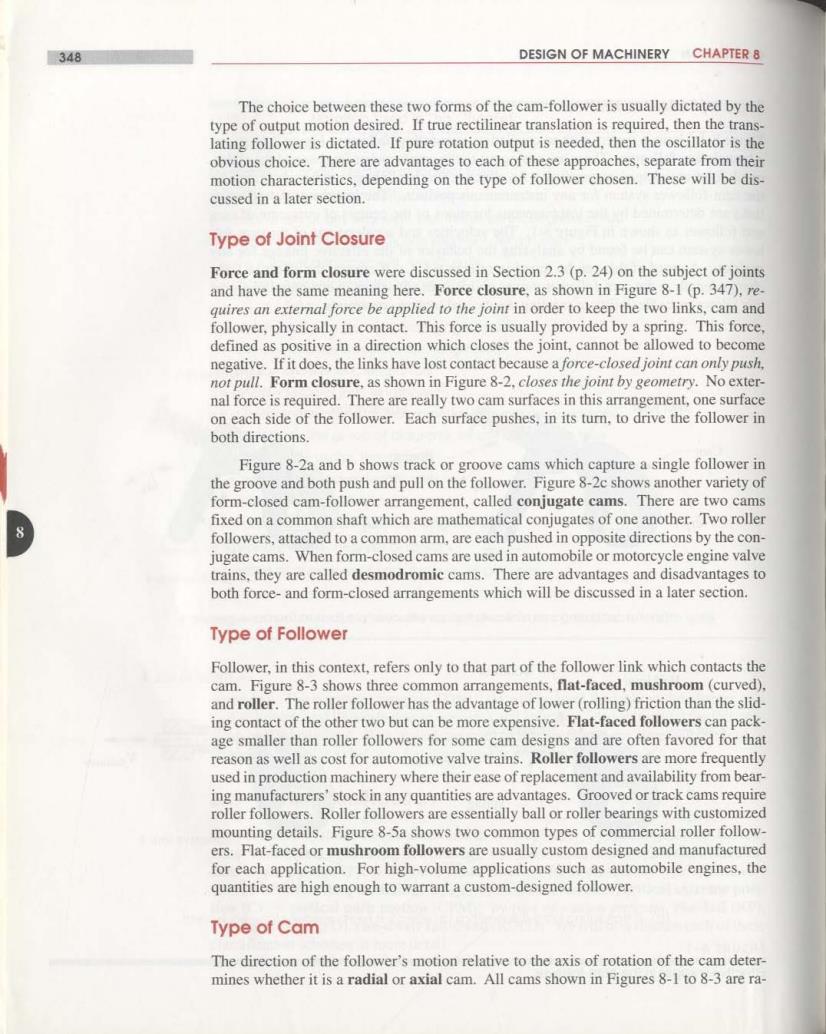正在加载图片...

348 DESIGN OF MACHINERY CHAPTER 8 The choice between these two forms of the cam-follower is usually dictated by the type of output motion desired.If true rectilinear translation is required,then the trans- lating follower is dictated.If pure rotation output is needed,then the oscillator is the obvious choice.There are advantages to each of these approaches,separate from their motion characteristics,depending on the type of follower chosen.These will be dis- cussed in a later section. Type of Joint Closure Force and form closure were discussed in Section 2.3(p.24)on the subject of joints and have the same meaning here.Force closure,as shown in Figure 8-1(p.347),re. quires an external force be applied to the joint in order to keep the two links,cam and follower,physically in contact.This force is usually provided by a spring.This force. defined as positive in a direction which closes the joint,cannot be allowed to become negative.If it does,the links have lost contact because a force-closed joint can only push. not pull.Form closure,as shown in Figure 8-2,closes the joint by geometry.No exter- nal force is required.There are really two cam surfaces in this arrangement,one surface on each side of the follower.Each surface pushes,in its turn.to drive the follower in both directions. Figure 8-2a and b shows track or groove cams which capture a single follower in the groove and both push and pull on the follower.Figure 8-2c shows another variety of form-closed cam-follower arrangement,called conjugate cams.There are two cams fixed on a common shaft which are mathematical conjugates of one another.Two roller followers,attached to a common arm,are each pushed in opposite directions by the con- jugate cams.When form-closed cams are used in automobile or motorcycle engine valve trains,they are called desmodromic cams.There are advantages and disadvantages to both force-and form-closed arrangements which will be discussed in a later section. Type of Follower Follower,in this context,refers only to that part of the follower link which contacts the cam.Figure 8-3 shows three common arrangements,flat-faced,mushroom(curved). and roller.The roller follower has the advantage of lower(rolling)friction than the slid- ing contact of the other two but can be more expensive.Flat-faced followers can pack- age smaller than roller followers for some cam designs and are often favored for that reason as well as cost for automotive valve trains.Roller followers are more frequently used in production machinery where their ease of replacement and availability from bear- ing manufacturers'stock in any quantities are advantages.Grooved or track cams require roller followers.Roller followers are essentially ball or roller bearings with customized mounting details.Figure 8-5a shows two common types of commercial roller follow- ers.Flat-faced or mushroom followers are usually custom designed and manufactured for each application.For high-volume applications such as automobile engines,the quantities are high enough to warrant a custom-designed follower. Type of Cam The direction of the follower's motion relative to the axis of rotation of the cam deter- mines whether it is a radial or axial cam.All cams shown in Figures 8-1 to 8-3 are ra-